A Wine-table is a late 15th-century device for facilitating after-dinner drinking, the cabinetmakers called it a "Gentleman's Social Table." It was always narrow and of semicircular or horseshoe form, and the guests sat round the outer circumference. In the earlier and simpler shapes, metal wells for bottles and ice were sunk into the surface of the table; they were fitted with brass lids. [1]
In later and more elaborate examples, the tables were fitted with a revolving wine carriage, bottle holder, or tray working upon a balanced arm enabling the bottles to be passed to any guest without shaking. The side opposite the guests was often fitted with a network bag. It has been conjectured that this bag was intended to hold biscuits, but it is much more likely that its function was to prevent glasses and bottles which might be upset from falling to the floor. The wine table might be drawn up to the fire in cold weather without inconvenience from the heat. It was fitted with curtains hung upon a brass frame and running upon rings. Sometimes the table was accompanied by a circular bottle stand supported on a tripod into which the bottles were deeply sunk to preserve them from the heat of the fire. Yet another form was circular, with a socket in the center for the bottle. Wine tables followed the fashion of other tables and were often inlaid with wood or brass. They are now exceedingly scarce. [1]

A kiln is a thermally insulated chamber, a type of oven, that produces temperatures sufficient to complete some process, such as hardening, drying, or chemical changes. Kilns have been used for millennia to turn objects made from clay into pottery, tiles and bricks. Various industries use rotary kilns for pyroprocessing and to transform many other materials.
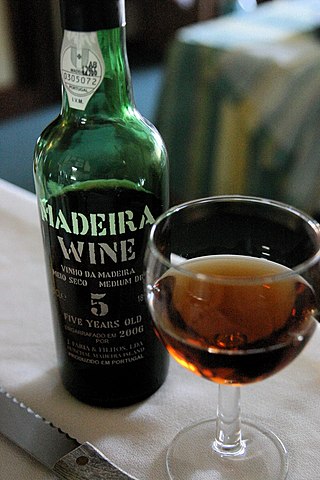
Madeira is a fortified wine made on the Portuguese Madeira Islands, off the coast of Africa. Madeira is produced in a variety of styles ranging from dry wines which can be consumed on their own, as an apéritif, to sweet wines usually consumed with dessert. Cheaper cooking versions are often flavoured with salt and pepper for use in cooking, but these are not fit for consumption as a beverage.

A kitchen is a room or part of a room used for cooking and food preparation in a dwelling or in a commercial establishment. A modern middle-class residential kitchen is typically equipped with a stove, a sink with hot and cold running water, a refrigerator, and worktops and kitchen cabinets arranged according to a modular design. Many households have a microwave oven, a dishwasher, and other electric appliances. The main functions of a kitchen are to store, prepare and cook food. The room or area may also be used for dining, entertaining and laundry. The design and construction of kitchens is a huge market all over the world.
Tubes and primers are used to ignite the propellant in projectile weapons.
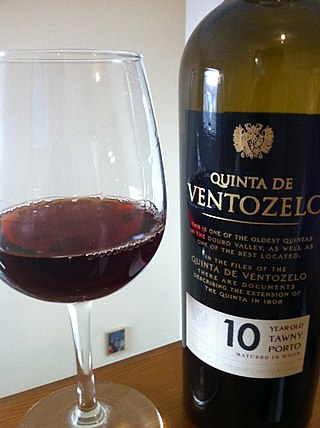
Port wine is a Portuguese fortified wine produced in the Douro Valley of northern Portugal. It is typically a sweet red wine, often served with dessert, although it also comes in dry, semi-dry, and white varieties.

A bandolier or a bandoleer is a pocketed belt for holding either individual cartridges, or belts of ammunition. It is usually slung sash-style over the shoulder and chest, with the ammunition pockets across the midriff and chest. Though functionally similar, they are distinct from chest rigs, which are designed to hold magazines instead.
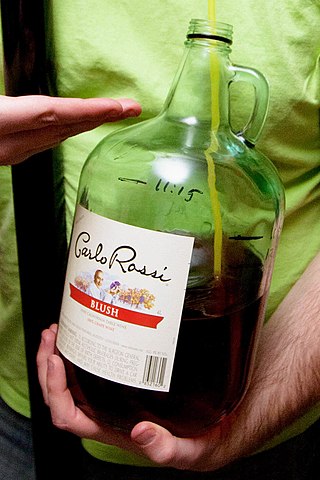
"Jug wine" is a term in the United States for inexpensive table wine typically bottled in a glass bottle or jug.

Boxed wine is a wine sold in a bag inside a box. This box is made from cardboard or corrugated fiberboard, which supports the plastic bag filled with wine. The wine flows out from a plastic push-release valve.

A chandelier is a branched ornamental light fixture designed to be mounted on ceilings or walls. Chandeliers are often ornate, and normally use incandescent light bulbs, though some modern designs also use fluorescent lamps and recently LEDs.

Service à la française is the practice of serving various dishes of meal at the same time, with the diners helping themselves from the serving dishes. That contrasts to service à la russe in which dishes are brought to the table sequentially and served individually, portioned by servants.

Red wine is a type of wine made from dark-colored grape varieties. The color of the wine can range from intense violet, typical of young wines, through to brick red for mature wines and brown for older red wines. The juice from most purple grapes is greenish-white, the red color coming from anthocyan pigments present in the skin of the grape. Much of the red wine production process involves extraction of color and flavor components from the grape skin.
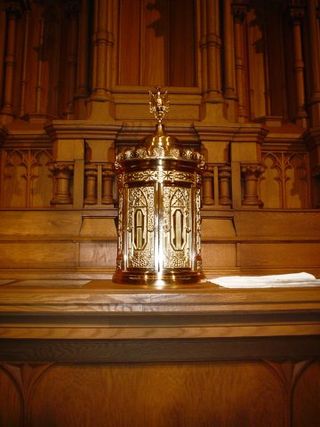
A tabernacle or sacrament house is a fixed, locked box in which the Eucharist is stored as part of the "reserved sacrament" rite. A container for the same purpose, which is set directly into a wall, is called an aumbry.
Wine accessories are things that may be used in the storage or serving of wine. Wine accessories include many items such as wine glasses, corkscrews, and wine racks.

A chafing dish is a metal cooking or serving pan on a stand with an alcohol burner holding chafing fuel below it. It is used for cooking at table, notably in Gueridon service, or as a food warmer for keeping dishes at a buffet warm.

A washstand or basin stand is a piece of furniture consisting of a small table or cabinet, usually supported on three or four legs, and most commonly made of mahogany, walnut, or rosewood, and made for holding a wash basin and water pitcher. The smaller varieties were used for rose-water ablutions, or for hair-powdering. The larger ones, which possessed receptacles for soap dishes, were the predecessors of the modern bathroom wash basin, or sink. Both varieties, often of very elegant form, were in extensive use throughout a large part of the 18th century and early-19th century, eventually disappearing with the advent of modern indoor plumbing.

An aircraft lavatory or plane toilet is a small room on an aircraft with a toilet and sink. They are commonplace on passenger flights except some short-haul flights. Aircraft toilets were historically chemical toilets, but many now use a vacuum flush system instead.

In winemaking, clarification and stabilization are the processes by which insoluble matter suspended in the wine is removed before bottling. This matter may include dead yeast cells (lees), bacteria, tartrates, proteins, pectins, various tannins and other phenolic compounds, as well as pieces of grape skin, pulp, stems and gums. Clarification and stabilization may involve fining, filtration, centrifugation, flotation, refrigeration, pasteurization, and/or barrel maturation and racking.
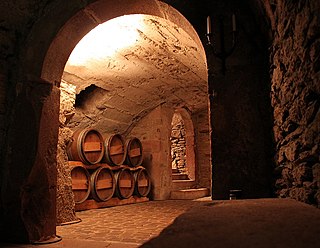
A buttery was originally a large cellar room under a monastery, in which food and drink were stored for the provisioning of strangers and passing guests. Nathan Bailey's An Universal Etymological English Dictionary gives "CELLARIST – one who keeps a Cella, or Buttery; the Butler in a religious House or Monastery." As the definition in John Stevens's The History of the Antient Abbeys shows, its initial function was to feed and water the guests rather than monks: "The Buttery; the Lodging for Guests". In a monastery a buttery was thus the place from which travellers would seek 'doles' of bread and weak ale, given at the exterior buttery door. The task of doling out this free food and drink would be the role of the butterer. At larger monasteries there would also be a basic hostelry, where travellers could sleep for free.

The Beaver Club was a gentleman's dining club founded in 1785 by the predominantly English-speaking men who had gained control of the fur trade of Montreal. According to the club's rules, the object of their meeting was "to bring together, at stated periods during the winter season, a set of men highly respectable in society, who had passed their best days in a savage country and had encountered the difficulties and dangers incident to a pursuit of the fur trade of Canada". Only fragmentary records remain of their meetings, but from these it is clear that the Beaver Club was "an animated expression of the esprit de corps of the North West Company". The men of the Beaver Club were the predecessors of Montreal's Square Milers.

Holland House was a New York City hotel located at 274–276 Fifth Avenue at the southwest corner of 30th Street in NoMad, Manhattan, New York City, with a frontage of 250 feet (76 m) on Fifth Avenue. The architects and designers were George Edward Harding & Gooch. A mercantile building by the 1920s, in the present day, it is a loft building.